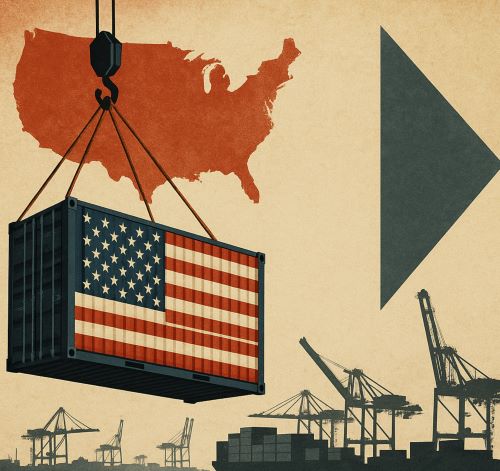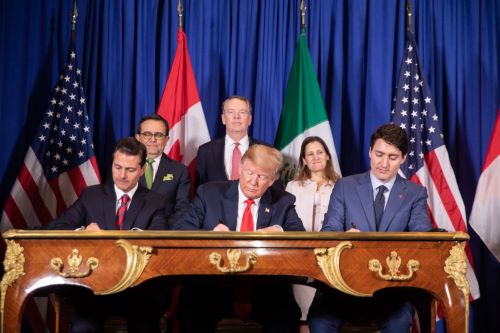

Trump has made it harder for American exporters to compete, not easier.

By Matthew A. McIntosh
Public Historian
Brewminate
Introduction: The Art of the Misdeal
Donald Trump’s presidency has always been framed in the language of business: deals, winners and losers, balance sheets, bottom lines. In his view, America’s trade relationships have long been a rigged game — one in which foreign nations outmaneuvered soft, globalist U.S. negotiators. His solution? A more aggressive, unilateral trade policy built on tariffs, threats, and economic nationalism.
But beneath the rhetoric of “America First” lies a quieter, more troubling reality: Trump’s trade strategy is increasingly hurting the very American businesses it claims to protect. While his focus has been on reducing imports and “bringing jobs home,” the retaliatory spiral he has unleashed — through tariffs, canceled agreements, and broken diplomatic channels — has made it harder and costlier for U.S. exporters to sell their goods abroad.
We will examine how that strategy, now resumed and intensified in his second term, is undermining America’s global trade standing — with direct consequences for farmers, manufacturers, and small businesses that depend on access to foreign markets.
The Return of Tariff Diplomacy
Trump’s approach to trade is rooted in a 20th-century mercantilist worldview: imports are bad, exports are good, and trade deficits mean you’re losing. In his first term, he unilaterally imposed tariffs on billions of dollars’ worth of goods from China, Europe, Canada, and Mexico. In his second term, he has doubled down, promising an across-the-board 10% tariff on all imports and floating a 60% tariff on Chinese goods.
While intended to punish foreign exporters and protect domestic industries, these tariffs have triggered retaliatory measures from U.S. trade partners — often aimed squarely at American exporters.
Farmers on the Front Line

Perhaps no sector has been hit harder than agriculture. In response to Trump’s tariffs on Chinese steel and other goods, Beijing slapped counter-tariffs on:
- U.S. soybeans
- Corn
- Pork
- Dairy products
- Wine and whiskey
China, once the top destination for American soybeans, shifted its sourcing to Brazil. U.S. farmers, already operating on thin margins, saw prices collapse and markets evaporate. While Trump introduced subsidy payments to offset losses (amounting to over $28 billion during his first term), these payouts were a temporary patch, not a structural solution — and many small farms didn’t survive the disruption.
Now in 2025, with tariffs returning and diplomatic channels weakened, those markets remain unstable. China’s trade relationships with Brazil, Russia, and Argentina have deepened — a lasting geopolitical shift directly tied to Trump’s policy.
Manufacturing’s Mixed Blessing
Trump’s tariffs were also meant to revive American manufacturing, particularly in steel and aluminum. While some domestic producers briefly benefited from price protections, many others — especially small manufacturers — rely on imported components and raw materials.
For example:
- Machinery and auto part makers faced higher input costs
- Export-oriented firms saw foreign demand drop as overseas buyers responded with tariffs of their own
- Supply chains became more volatile, especially in precision tools, semiconductors, and electronics
In effect, Trump’s policies created a “tax on production” — especially for businesses that import parts, assemble products in the U.S., and then export the finished goods. As one National Association of Manufacturers report put it: “We are paying more to make less.”
Small Business, Big Trouble

Large multinationals can absorb trade shocks. Small and mid-sized exporters cannot.
Many of these firms:
- Lack the capital to reengineer supply chains on short notice
- Depend on stable bilateral agreements to secure long-term contracts
- Have little leverage to renegotiate prices with foreign buyers
Under Trump’s strategy, several critical trade agreements have been weakened or abandoned altogether:
- The Trans-Pacific Partnership (TPP) — abandoned by Trump in 2017, forfeiting access to growing Pacific markets
- NAFTA — replaced by the USMCA, but with added complexity and rules-of-origin burdens that hurt smaller exporters
- EU Trade Talks — stalled, with renewed threats of car tariffs resurfacing in 2025
Without predictable frameworks, small exporters face uncertainty, higher costs, and lower competitiveness abroad — even as foreign firms continue to benefit from trade agreements the U.S. exited.
Services and Intellectual Property Left Behind
The U.S. is not just a goods exporter — it dominates in services, from software and financial services to entertainment and education. But Trump’s approach to trade has largely ignored service-sector exporters, focusing instead on old-school heavy industry.
Worse:
- Visa restrictions and “America First” immigration policies have made it harder for U.S. universities and tech firms to attract foreign talent — weakening exportable education and innovation
- Aggressive IP demands have antagonized allies, pushing them toward regional frameworks that exclude the U.S. from shared innovation protections
By treating trade as a zero-sum game centered on physical goods, Trump’s strategy has missed the 21st-century engine of American export growth.
Lost Credibility on the Global Stage
Trade is more than economics — it is also diplomacy, a way of forging alliances and projecting influence. Under Trump, America’s reputation as a reliable trade partner has suffered.
Allies have grown wary of:
- Sudden tariff impositions
- Withdrawal from multilateral agreements
- Politicized trade retaliation
Meanwhile, rivals like China and blocs like the EU have stepped into the vacuum, signing trade agreements that exclude or isolate the U.S.:
- The Regional Comprehensive Economic Partnership (RCEP) — a massive Asia-Pacific trade bloc including China
- The EU-Mercosur Agreement — deepening Europe’s reach in South America
- The Comprehensive and Progressive Agreement for Trans-Pacific Partnership (CPTPP) — which proceeded without U.S. involvement
By treating trade policy as a series of threats rather than negotiations, Trump has diminished U.S. exporters’ access to these new markets — not through protectionism, but through absence.
Conclusion: A Strategy That Backfires
Donald Trump’s trade policy is animated by a simple, visceral narrative: that America has been cheated, and that only by going it alone can we win again. But trade is not war — it is a network, a relationship, and above all, a two-way street.
By alienating trade partners, raising costs on inputs, and provoking retaliation, Trump has made it harder for American exporters to compete, not easier. What was promised as economic populism has often delivered economic sabotage — not just for foreign firms, but for American farmers, manufacturers, and innovators struggling to reach the world. As this strategy continues into his second term, the question for exporters becomes existential: how many more “wins” like this can they survive?
Originally published by Brewminate, 07.01.2025, under the terms of a Creative Commons Attribution-NonCommercial-NoDerivatives 4.0 International license.


